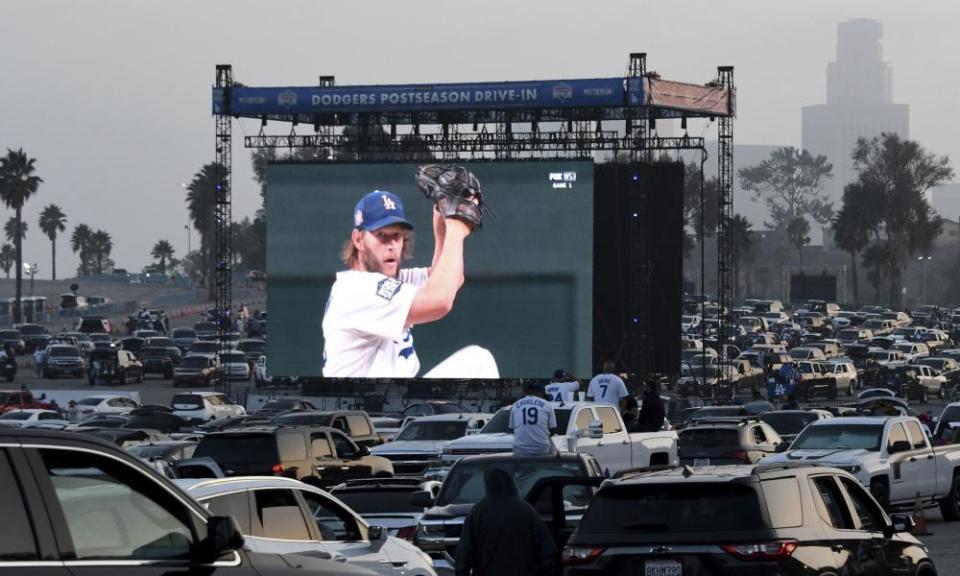The exquisite catharsis of watching Clayton Kershaw fail to implode

In the 178th postseason inning he’s pitched, facing the first batter of his 29 October start, the best pitcher this century allowed a hit.
It might have been nothing, early jitters for the Dodgers’ ace, that gradual settling that even the mightiest arms require. But in the case of Clayton Kershaw, a million minds worried that it might be more. One hit may lead to two, three – to sliders that don’t drop and curveballs that won’t curve and another of Kershaw’s fabled playoff meltdowns.
Or a hit might just be a hit. On Tuesday, that’s all it was. It took until the fifth inning, when the Dodgers led 2-0, for Kershaw to allow his second (and final) hit of the night: a solo home run to Rays outfielder Kevin Kiermaier. Kershaw would make it through another frame – groundout, foul out, groundout – ending his evening with eight strikeouts, a walk and a commanding lead.
And for a day, for a few more games, at least, the existential dread of his playoff existence was put on hold.
The 32-year-old starter went into Tuesday, an 8-3 Los Angeles victory in Game 1 of the World Series, with a career ERA of 2.43 but with a postseason ERA of 4.31. His World Series mark, 5.03, is worse. But here’s an asterisk, some context to the madness: 5.03 includes a start in 2017 in which Kershaw gave up six earned runs – and in which his opponent, the Houston Astros, benefited from an elaborate sign-stealing scheme. So they’re not quite as bad as they look, maybe, these World Series woes. In fact, maybe none of this is.
Related: Los Angeles Dodgers too hot for Tampa Bay Rays in Game 1 of World Series
Tuesday didn’t erase the mess of some of Kershaw’s highest-pressure starts. There’s no denying his implosion in Game 6 of the 2013 NLCS. He faltered again in 2016 in an elimination game against the Cubs, then he started the 2018 World Series with a thud. And in last year’s playoffs he allowed two late, back-to-back home runs when the Dodgers had the lead as they were eliminated by the Washington Nationals. He’s been far from sharp in another dozen or so October outings, many of which have seen the Dodgers push him a batter too long, trusting a pitcher who earns it for six months each spring and summer.

A few more asterisks, now: When Kershaw beat the Rays, it marked the ninth time he’d pitched at least six innings in an October start without allowing more than a hit and a walk. That’s the most of any starter in MLB history. And when he left the mound at the end of the sixth, ready to ice his shoulder and hug teammates and relax on a quiet bench, Kershaw had 201 career postseason strikeouts. Only Justin Verlander, with 205, has more. Another sharp World Series outing this fall – another middling one, even – and he’ll edge into first all-time.
It’s hard to say what any of that proves. Every rule has an exception. Kershaw is otherworldly, except in October. He’s a disaster then, except when he’s occasionally still great. And there’s no shortage of theorizing as to why. Jitters, curses, rotten luck. Bad managing, the pesky fact that postseason competition is always steeper. The source of Kershaw’s struggles, probably, is a mix of nonsense and logic.
Logically, Game 1 made sense. Kershaw faced a Rays team that collectively hit .209 in the first three rounds of the 2020 playoffs. Some combination of their leaden bats and his humming slider made for a montage of whiffs. Nineteen, to be exact. Tampa’s batters missed 50% of the pitches they swung at, giving Kershaw the highest swing-and-miss rate of any game in his 13-year career.
“It was better tonight than the last one, for sure,” he said after the game. “I think, the first inning, I was spiking some sliders there. Fortunate to get out of that first without any runs, and then after that, I kind of locked it in.”
If Tuesday was a catharsis for Kershaw, it wasn’t his first. There have been plenty of other playoff games when he’s pitched like the version of himself worth $93m over three years. He was last absolved of his postseason sins in Game 2 of the Wild Card round, when he tossed eight shutout innings, and before that in Game 5 of the 2018 NLCS. Kershaw dazzles nearly as often as he combusts – but the combustions loom larger, louder.
When he next takes the mound, Kershaw will face the same chatter that echoed before Game 1, the same whispers that grow louder every time his arm falters. That’s part of the thrill of it, though: It’s as exhilarating when he’s lights-out as it is when he’s haywire.
This wasn’t the best World Series start of Kershaw’s career. That came in 2017, Game 1, when he struck out 11 in seven innings against Houston. But his gem against the Rays was close, and he was in complete control. His fastball velocity ticked up in 2020, and the 60-game regular season left him in far better shape this fall than he would be after 162. So maybe Tuesday started something new. Maybe this is Kershaw’s series to win, his legacy to cement.
Or maybe a game is just a game.

